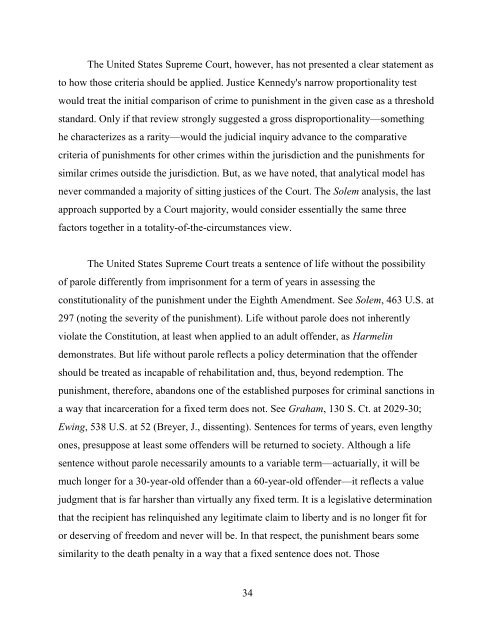State v. Proctor - Kansas Judicial Branch
State v. Proctor - Kansas Judicial Branch
State v. Proctor - Kansas Judicial Branch
Create successful ePaper yourself
Turn your PDF publications into a flip-book with our unique Google optimized e-Paper software.
The United <strong>State</strong>s Supreme Court, however, has not presented a clear statement as<br />
to how those criteria should be applied. Justice Kennedy's narrow proportionality test<br />
would treat the initial comparison of crime to punishment in the given case as a threshold<br />
standard. Only if that review strongly suggested a gross disproportionality—something<br />
he characterizes as a rarity—would the judicial inquiry advance to the comparative<br />
criteria of punishments for other crimes within the jurisdiction and the punishments for<br />
similar crimes outside the jurisdiction. But, as we have noted, that analytical model has<br />
never commanded a majority of sitting justices of the Court. The Solem analysis, the last<br />
approach supported by a Court majority, would consider essentially the same three<br />
factors together in a totality-of-the-circumstances view.<br />
The United <strong>State</strong>s Supreme Court treats a sentence of life without the possibility<br />
of parole differently from imprisonment for a term of years in assessing the<br />
constitutionality of the punishment under the Eighth Amendment. See Solem, 463 U.S. at<br />
297 (noting the severity of the punishment). Life without parole does not inherently<br />
violate the Constitution, at least when applied to an adult offender, as Harmelin<br />
demonstrates. But life without parole reflects a policy determination that the offender<br />
should be treated as incapable of rehabilitation and, thus, beyond redemption. The<br />
punishment, therefore, abandons one of the established purposes for criminal sanctions in<br />
a way that incarceration for a fixed term does not. See Graham, 130 S. Ct. at 2029-30;<br />
Ewing, 538 U.S. at 52 (Breyer, J., dissenting). Sentences for terms of years, even lengthy<br />
ones, presuppose at least some offenders will be returned to society. Although a life<br />
sentence without parole necessarily amounts to a variable term—actuarially, it will be<br />
much longer for a 30-year-old offender than a 60-year-old offender—it reflects a value<br />
judgment that is far harsher than virtually any fixed term. It is a legislative determination<br />
that the recipient has relinquished any legitimate claim to liberty and is no longer fit for<br />
or deserving of freedom and never will be. In that respect, the punishment bears some<br />
similarity to the death penalty in a way that a fixed sentence does not. Those<br />
34

















